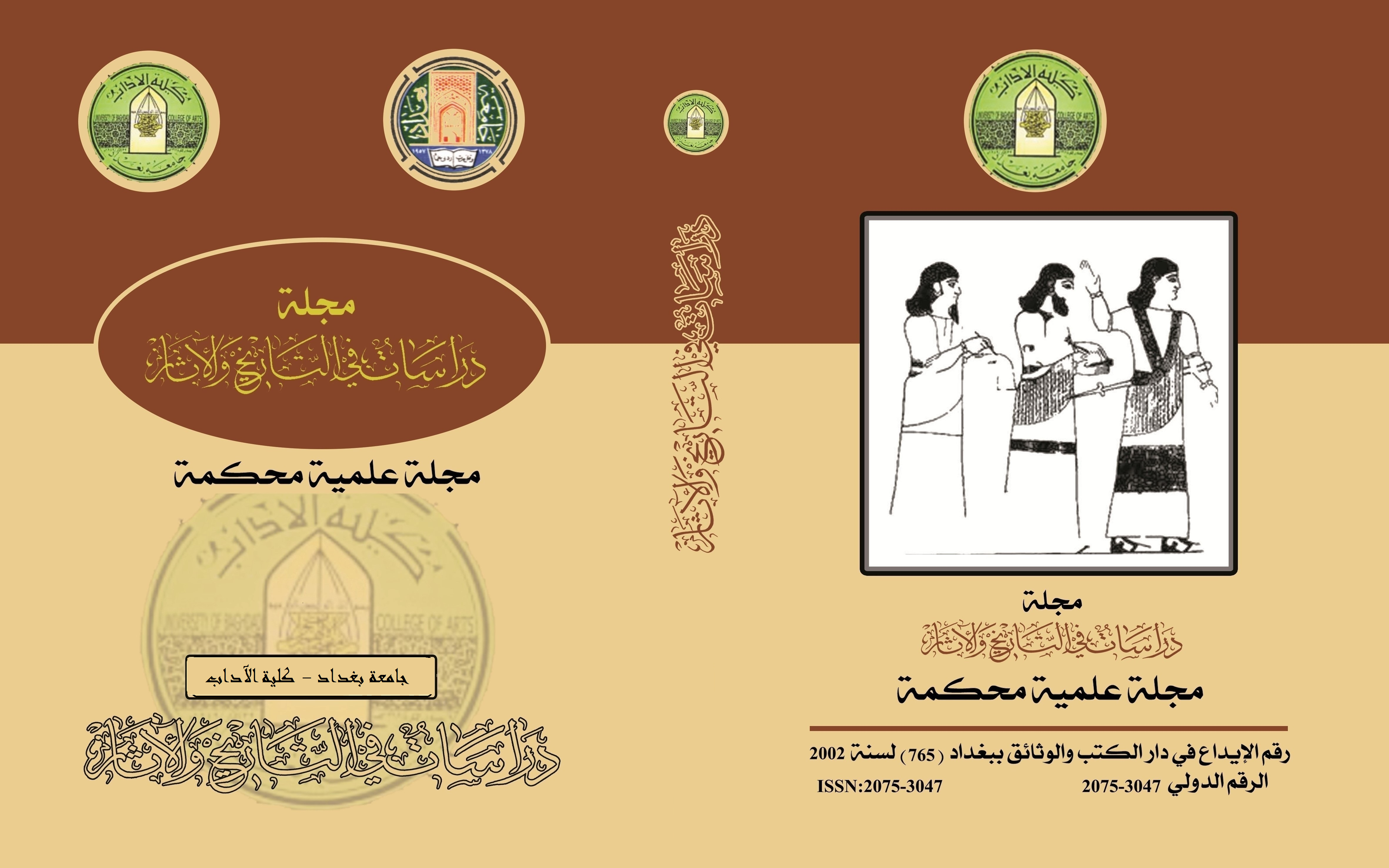الدوافع الدينية للإستشراق
الكلمات المفتاحية:
دوافع، دينية، استشراقالملخص
يمثل الإستشراق تيارا واسعا من الباحثين الغربيين الذين أهتموا بآداب الشرق وعلومه ومعتقداته، وبحثوا في لغاته وثقافاته، وقد أوضح هذا التيار الرؤيا الغربية عن العالم العربي والإسلامي، وقد عكست هذه التصورات والرؤى طبيعة الصراع بين الحضارتين الشرقية والغربية وكذلك الصراع بين المسيحية والإسلام. وقد شغلت الظاهرة الإستشراقية حيزا كبيرا من حياة المجتمع الأوربي والمجتمع العربي الإسلامي، وكونت بمرور الزمن مَعلما رئيسيا مهما في مجال الفكر والثقافة والأدب، كان له ابرز الاثر في إحداث نهضة علمية وادبية في اوروبا بما نقلته من علوم الشرق وآدابهم وثقافتهم ، وانعكس اثر الإستشراق على ميدان عمله الجغرافي وهو الشرق ذاته، كونه حفز العرب والمسلمين الى الرجوع الى تراثهم، والبحث عن ردود مناسبة للدفاع عن كيانهم ومعتقدهم، وفي الوقت الذي بالغ فيه بعض المستشرقون في كتاباتهم بوصف حُسن الشرق وجماله وسحره، بالغ مستشرقون آخرون في احتقار المجتمع الشرق والتقليل من شأنه.
المراجع
-أحمامو، عبد العالي، الإستشراق الاهداف والغايات، مجلة دراسات استشراقية، العدد 14 ربيع الاول 2018.
-ابن الاثير، أبو الحسن علي بن ابي الاكرم الشيباني (630 هــ) الكامل في التاريخ، مراجعة محمد يوسف الدقاق، (بيروت، دار الكتب العلمية ،2003م) م10.
-اوليري، دي لاسي، الفكر العربي ومركزه في التاريخ، تر: اسماعيل البيطار، ط1، (بيروت، دار الكتاب اللبناني، 1974).
-بارت، رودي، الدراسات العربية والإسلامية في الجامعات الألمانية، ترجمة: مصطفى ماهر، (القاهرة، المركز القومي للترجمة، 2011م).
- بدوي، عبد الرحمن، موسوعة المستشرقين، ط3 (بيروت، المؤسسة العربية للدراسات والنشر، 1993).
البنداق، محمد صالح، المستشرقون وترجمة القرآن الكريم، (بيروت، مطبعة الآفاق الجديدة،1980).
-البهي، محمد، المبشرون والمستشرقون في موقفهم من الإسلام، ط3(القاهرة، د، ت، مطبعة الأزهر).
-التكريتي، بهجت كامل، الإستشراق المعنى والأهداف، مجلة كلية الآداب العدد85.
-الجهني، مانع بن حماد، الموسوعة الميسرة في الأديان والمذاهب والأحزاب المعاصرة، ط4(الرياض، دار الندوة العالمية للطباعة والنشر والتوزيع، 2003م).
-حميش، بنسالم، الإستشراق في افق انسداده، ط1(الرباط: منشورات المجلس القومي للثقافة العربية، 1991).
-حميش، بنسالم، العرب والإسلام في مرايا الإستشراق ط1(القاهرة، دار الشروق،2011).
-درويش، احمد، الإستشراق الفرنسي والادب العربي (القاهرة، الهيئة العامة المصرية للكتاب،1997).
-الزيات، احمد حسن، تاريخ الأدب العربي (القاهرة، دار نهضة مصر).
-الزيادي، محمد فتح الله، الإستشراق أهدافه ووسائله: دراسة تطبيقيه حول منج الغربيين في دراسة ابن خلدون ط1(طرابلس، مطبعة دار قتيبه، 1998).
-- سالم الحاج، ساسي، نقد الخطاب الإستشراقي، الظاهرة الإستشراقية وأثرها في الدراسات الإسلامية، (بيروت، دار المدار الإسلامي، 2002م).
-السامرائي، قاسم، الإستشراق بين الموضوعية والافتعالية، ط1(الرياض، دار الرفاعي للنشر والطباعة والتوزيع، 198).
-السباعي، مصطفى، الإستشراق والمستشرقون مالهم وماعليهم، ط3(د/م:1985).
-سعيد، أدورد، الإستشراق، ترجمة كمال ابو ديب، ط2(بيروت: مؤسسة الابحاث العربية، 1948).
-سوذرن، ريتشارد، صورة الإسلام في اوروبا في القرون الوسطى، ترجمة رضوان السيد، ط1(بيروت، دار المدى الإسلامي،2006).
-شايب، لخضر، نبوة محمد في الفكر الإستشراقي المعاصر، (باتنه، د/م، 2001).
-عقيقي، نجيب، المستشرقون، ط3(القاهرة، دار المعارف،1964).
-- غراب، أحمد عبد الحميد، رؤية إسلامية للاستشراق، ط1(الرياض، دار الاصالة،1988).
-الفيروز بادي، محمد بن يعقوب مجد الدين، القاموس المحيط، تحقيق، محمد نعيم العرقسوسي ط8(بيروت، مؤسسة الرسالة،2002).
-مصطفى، إسماعيل عبد الفتاح، الإستشراق بين النشأة والأهداف، حولية كلية أصول الدين والدعوة الإسلامية بطنطا، المجلد 8، العدد8 ، السنة2016.
-ابن منظور، ابي الفضل جمال الدين محمد بن مكرم(ت711)، لسان العرب، (بيروت: دار صادر، د/ت).
-ناجي، عبد الجبارـ الإستشراق في التاريخ. الاشكاليات، الدوافع، التوجهات، الاهتمامات، ط1(بيروت، المركز الأكاديمي للأبحاث، 2013م).
-نويهض، وليد، الاستغراب السلبي كتمثّل للاستشراق في اختلاف الرؤية بين الغالب والمغلوب على أمره، مجلة الاستغراب، السنة الاولى العدد1، 2015.
-النبهاني، محمد فاروق، الإستشراق تعريفه مدارسه، آثاره، (الرباط، المنظمة الإسلامية للتربية والثقافة والعلوم، 2012).
-بن نبي، مالك، إنتاج المستشرقين وأثره في الفكر الإسلامي الحديث، ط1(بيروت، دار الارشاد للطباعة والنشر والتوزيع،1969).
-ناجي، عبد الجبارـ الإستشراق في التاريخ. الاشكاليات، الدوافع، التوجهات، الاهتمامات، ط1(بيروت، المركز الأكاديمي للأبحاث، 2013م).
-نويهض، وليد، الاستغراب السلبي كتمثّل للاستشراق في اختلاف الرؤية بين الغالب والمغلوب على أمره، مجلة الاستغراب، السنة الاولى العدد1، 2015.
-هيكل، محمد حسنين، حياة محمد، ط14(القاهرة: دار المعارف، د/ت).
-بن نبي، مالك، إنتاج المستشرقين وأثره في الفكر الإسلامي الحديث، ط1(بيروت، دار الارشاد للطباعة والنشر والتوزيع،1969).
-النبهاني، محمد فاروق، الإستشراق تعريفه مدارسه، آثاره، (الرباط، المنظمة الإسلامية للتربية والثقافة والعلوم، 2012).
-ناجي، عبد الجبارـ الإستشراق في التاريخ. الاشكاليات، الدوافع، التوجهات، الاهتمامات، ط1(بيروت، المركز الأكاديمي للأبحاث، 2013م)
.35-Waadenburg,J.D.J, "Mustashrikun"The Encyclopedia Of Islam new Edition , Leiden –new EJ.Brill 1993.
التنزيلات
منشور
إصدار
القسم
الرخصة

هذا العمل مرخص بموجب Creative Commons Attribution 4.0 International License.
:حقوق الطبع والنشر والترخيص
بالنسبة لجميع البحوث المنشورة في مجلة دراسات في التاريخ والآثار، يحتفظ الباحثون بحقوق النشر. يتم ترخيص البحوث بموجب ترخيص Creative Commons CC BY 4.0 المفتوح ، مما يعني أنه يجوز لأي شخص تنزيل البحث وقراءته مجانًا. بالإضافة إلى ذلك ، يجوز إعادة استخدام البحث واقتباسه شريطة أن يتم الاستشهاد المصدر المنشور الأصلي. تتيح هذه الشروط الاستخدام الأقصى لعمل الباحث وعرضه.
:إعادة إنتاج البحوث المنشورة من الناشرين الآخرين
من الضروري للغاية أن يحصل الباحثون على إذن لإعادة إنتاج أي بحث منشورة (أشكال أو مخططات أو جداول أو أي مقتطفات من نص) لا يدخل في نطاق الملكية العامة أو لا يملكون حقوق نشرها. يجب أن يطلب الباحثون إذنًا من مؤلف حقوق النشر (عادة ما يكون الناشر).
يطلب الإذن في الحالات التالية:
بحوثك الخاصة المنشورة من قِبل ناشرين آخرين ولم تحتفظ بحقوق النشر الخاصة بها.
مقتطفات كبيرة من بحوث أي شخص أو سلسلة من البحوث المنشورة.
استخدم الجداول والرسوم البيانية والمخططات والمخططات والأعمال الفنية إذا لم يتم التعديل عليها.
الصور الفوتوغرافية التي لا تملك حقوق لنشرها.
لا يطلب الإذن في الحالات التالية:
إعادة بناء الجدول الخاص بك مع البيانات المنشورة بالفعل في مكان آخر. يرجى ملاحظة أنه في هذه الحالة يجب عليك ذكر مصدر البيانات في شكل "بيانات من ..." أو "مقتبس من ...".
تعتبر عروض الأسعار القصيرة معقولة الاستخدام العادل ، وبالتالي لا تتطلب إذنًا.
الرسوم البيانية ، الرسوم البيانية ، المخططات ، الأعمال الفنية التي أعاد الباحث رسمها بالكامل والتي تم تغييرها بشكل ملحوظ إلى درجة لا تتطلب الاعتراف.
الحصول على إذن
لتجنب التأخير غير الضروري في عملية النشر ، يجب أن تبدأ في الحصول على أذونات في أقرب وقت ممكن. لا يمكن لمجلة الآداب نشر بحث مقتبس من منشورات أخرى دون إذن.
قد يمنحك مالك حقوق الطبع والنشر تعليمات بشأن شكل الإقرار الواجب اتباعه لتوثيق عمله ؛ بخلاف ذلك ، اتبع النمط: "مستنسخ بإذن من [المؤلف] ، [كتاب / المجلة] ؛ نشره [الناشر] ، [السنة]." في نهاية شرح الجدول ، الشكل أو المخطط.



















